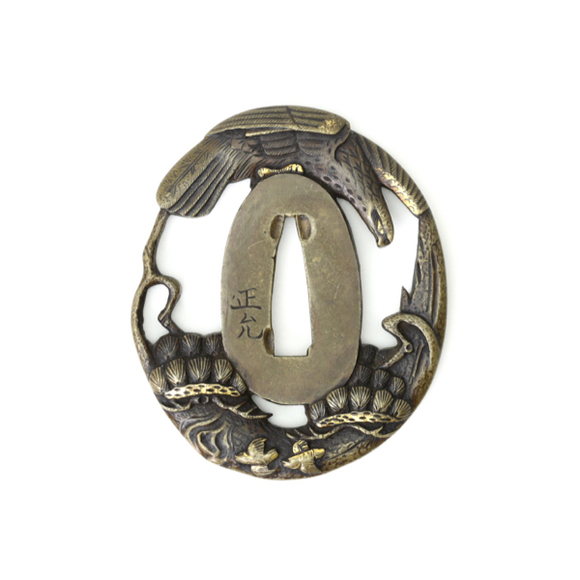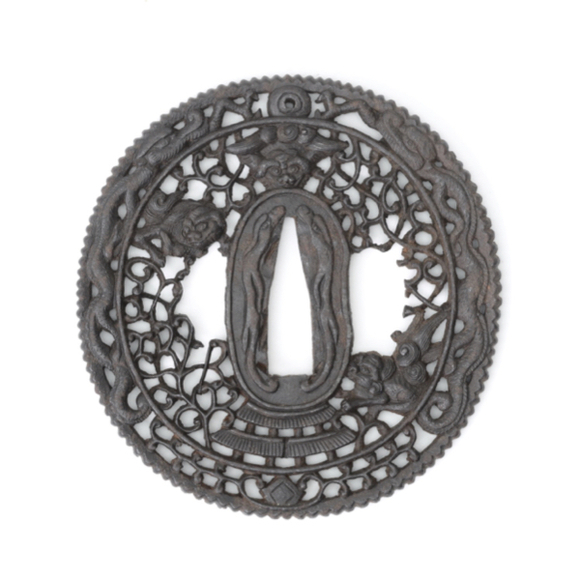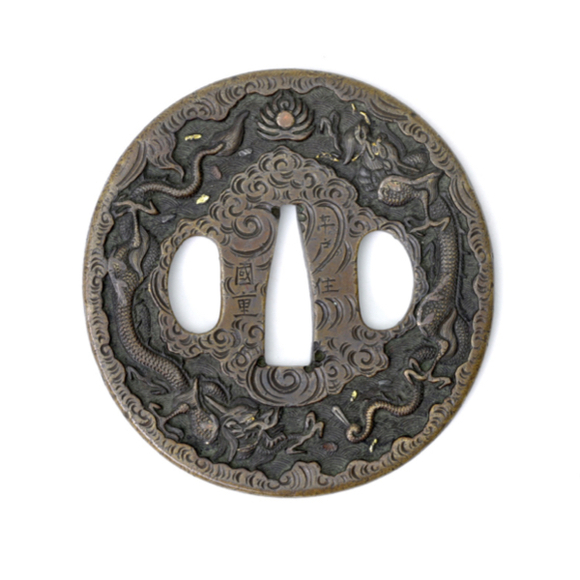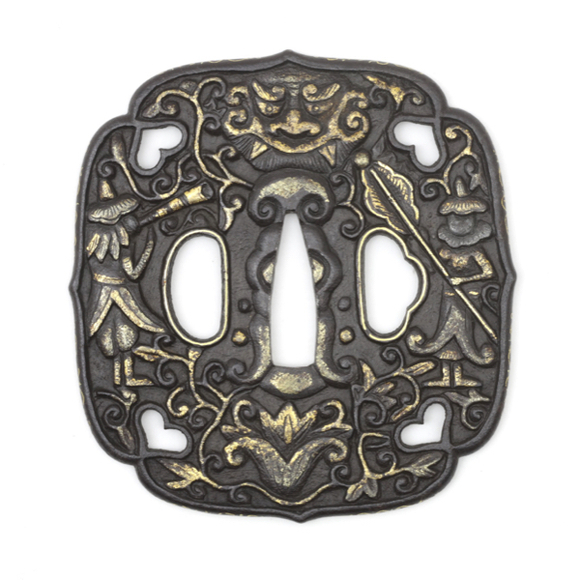Language: Japanese
Source: In common use
Description
Itomaki no tachi (糸巻太刀) literally means "silk wrapped great sword". It is a type of Japanese slung sword, tachi, that was worn mainly ceremoniously. It differs from the regular tachi in that the upper part of the scabbard is also wrapped with silk ribbon, just like the hilt. The scabbard wrapping is called watari-maki (渡巻) or saya-maki (鞘巻), and so the style of tachi is also sometimes called sayamaki no tachi (鞘巻太刀) or "scabbard wrapped great sword".1
This kind of koshirae often holds precious swords that are centuries older than the mountings. 13th-16th century swords by Bizen or Soshū masters are often seen.


An itomaki no tachi that was worn with formal court dress during the Edo period.
Sold by Mandarin Mansion in 2022.
Origins
The style appears to date from at least the late Heian period (794-1185 A.D.) to the early Kamakura period (1192-1333 A.D.).2 It was first probably mainly practical in nature: The added wrapping provided better grip during the pulling of the sword and also protected the scabbard from the rubbing against the armor.3
An early example of such a tachi koshirae is that of the Shishiō (獅子王) or "lion king" sword.4 It belonged to the warrior/poet Minamoto no Yorimasa (1104-1180 A.D.) and later to emperor Tokogawa Ieyasu (1543-1616 A.D.). The sword is from the Heian period, forged in the Yamato tradition. The koshirae are probably late Heian to early Kamakura period, so circa 1200 A.D.

Koshirae of the Shishiō (獅子王) or "lion king".
Important Cultural Property (jūyō bunkazai), and preserved in the Tōkyō National Museum.

Nanboku-chō period (14th century) tachi koshirae with sayamaki.
Important Cultural Property (jūyō bunkazai), and preserved in the Tōkyō National Museum.
Edo period use
During the Edo period, this style was elevated to a ceremonial style, to be worn with the formal dress called reifuku (礼服). One could also wear it with the chiisagatana (小さ刀) a shortish sword with a blade length of 1 shaku 5 sun and 1 shaku 8 sun (~ 45.45 ~ 54.54 cm).6 The reifuku was the second most formal dress, only surpassed by the taireifuku (大礼服), worn together with the archaic kazari-tachi or efu no tachi.
These formal itomaki no tachi were mainly executed with fittings in black shakudō and with family crests (mon) in gold, often done by the Goto family of sword fitting makers who worked directly for the Tokugawa shogunate.

Classic Edo tachi mounts by the Goto line.
In this case exhibiting the paulownia mon of the ruling Tokugawa house.
They typically come in fine scabbards, often with lacquer work consisting of gold flakes in clear lacquer called nashiji such as the one at the start of the article.5

Edo period itomaki no tachi scabbard with gold sprinkled lacquer (nashiji) and Tokugawa family crests.
Mandarin Mansion inventory 2022.
Notes
1. Markus Sesko; Encyclopedia of Japanese swords. Markus Sesko Print and Publishing: Lulu Enterprises, Inc. 2014. Page 142.
2. Ibid.
3. Ibid.
4. Taken from Japanese Sword Legends blog by Markus Sesko.
5. Markus Sesko; Koshirae Taikan. Markus Sesko Print and Publishing: Lulu Enterprises, Inc. 2014. Page 164.
6. Markus Sesko; Koshirae Taikan. Markus Sesko Print and Publishing: Lulu Enterprises, Inc. 2014. Page 190.
Notable examples
A number of notable itomaki no tachi exist in collections around the world.
Arguably one of the most famous is the koshirae of the Dojigiri, or "Demon Cutter" by Ko-Hoki smith Yasutsuna. It is a national treasure, now housed in the Tokyo National Museum. The sword was initially dated to the 9th century but more recent scholarship puts Yasutsuna's working period around that of Sanjo Munechika of around 1000 A.D. In any case, its one of the earliest curved swords of Japan. It is one of the Tenka-Goken (天下五剣) or "Five [Greatest] Swords under Heaven" and possibly the most celebrated of them all. You can barely open a Japanese sword book without seeing the Dojigiri on one of its pages.

Koshirae of the Dojigiri. Believed to date from the Momoyama period (1568-1600).
National Treasure. Tokyo National Museum.
Many great swords that were presented were also in itomaki no tachi. An example is a Ko-Aoe school tachi of the Kamakura period (1192-1333 A.D.) forged by Bichu Masatsune. It was presented to the Tsurugaoka Hachimangu Shrine in Kamakura by Tokugawa Yoshimune, probably in 1736 when he had the Shrine restored.

Itomaki no tachi koshirae for a Ko-Aoe Bichu Masatsune sword.
Presented to the Tsurugaoka Hachimangu Shrine in Kamakura by Tokugawa Yoshimune, probably in 1736.
Tsurugaoka Hachimangu Shrine collection.
The following sword was a 14th-century Bizen sword attributed to Bishū Osafune Hidemitsu (備州長船秀光) by the accompanying origami issued by sword polisher Takada Hon'ami in 1863. It was presented to the imperial court in Kyoto by Tokugawa Shogun Iemochi in 1864. It has two koshirae, one of them an itomaki no tachi which was the fashion.

Itomaki no tachi koshirae belonging to a 14th-century Bizen sword that was presented to the imperial court by the Tokugawa Shogun in 1864.
Its mountings combine the Tokugawa paulownia crest with the imperial chrysanthemum.
Tokyo National Museum, accession number F-211.
As presentation swords
Apart from being formal court swords, the itomaki no tachi was also the style often presented to (foreign) dignitaries. Examples include:
A tachi signed and dated 1860, probably a present to Queen Victoria by Shōgun Tokugawa Iemochi.
British Royal Collection Trust, namely RCIN 72787.1
A tachi made in 1860, presented by Tokugawa Iemochi to Queen Victoria.
Now in the Victoria & Albert Museum accession number 265&A-1865.
A tachi presented to by Emperor Meiji to Dutch Queen Wilhelmina in 1898.
Now in the Dutch Royal Collection, accession number MU-5437a & MU-5437b.
A tachi from the collection of Sir Claude MacDonald, the first British ambassador to Japan from 1905 to 1912.
Now in the Victoria & Albert Museum accession number M.139:1-1929.
Notes
1. Also see Rachel Peat; Japan: Courts and Culture. London. Royal Collection Trust. 2020. And a similar piece, RCIN 62622.
Other itomaki no tachi in non-Japanese collections
Acquired in Japan by Ernest Francisco Fenollosa before 1886.
Now in the Boston Museum of Fine Arts, accession number 11.5097.3a-b.
Bequeathed by Robert Wylie Lloyd in 1958.
Now in the British Museum, accession number 1958,0730.149.a-d.






